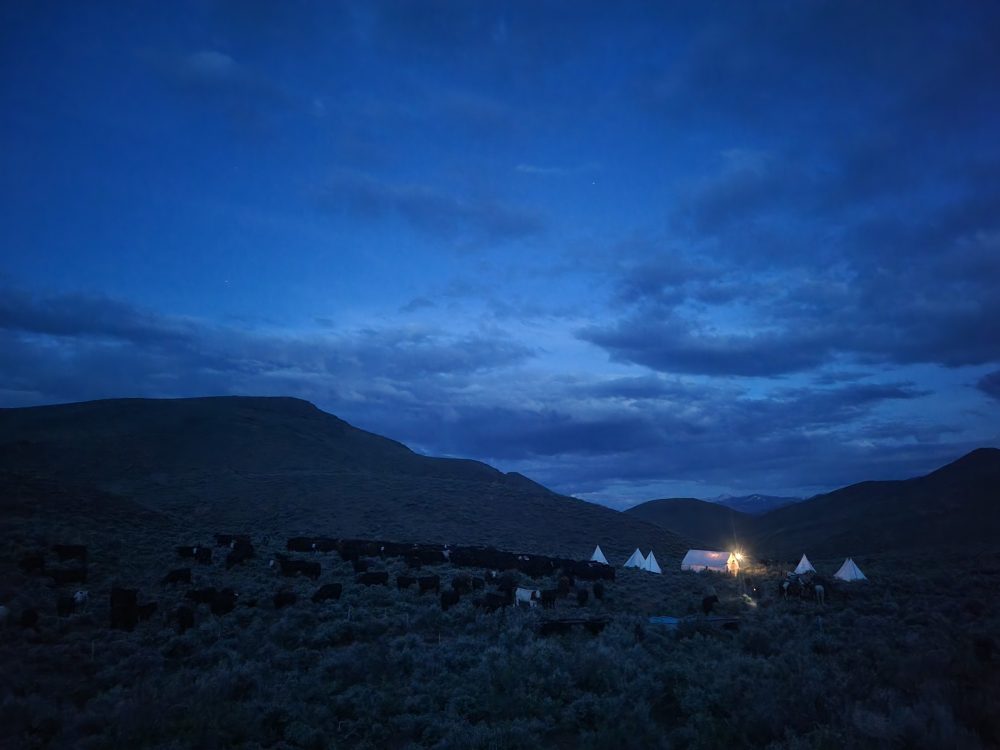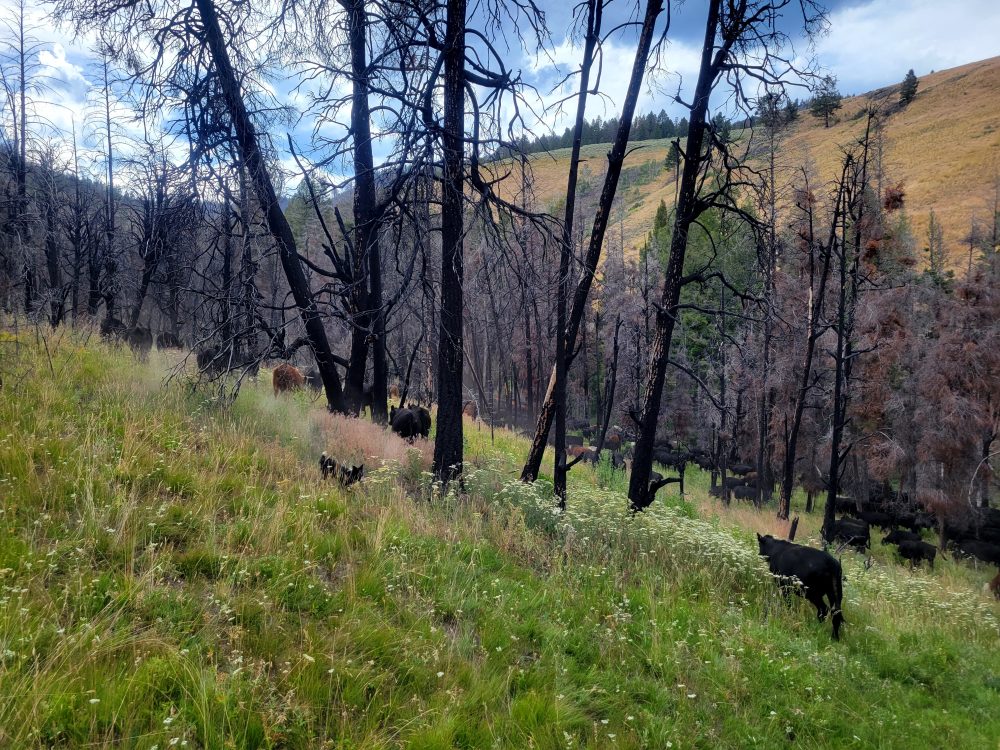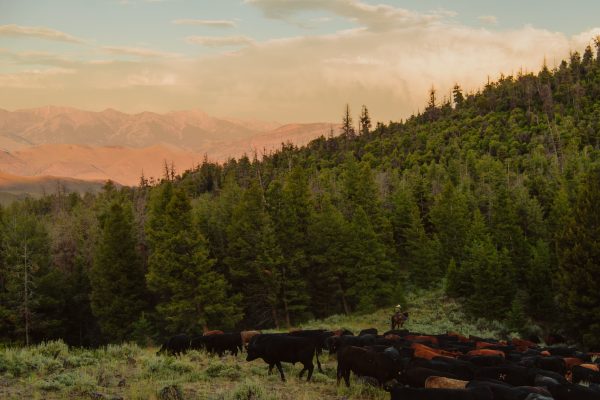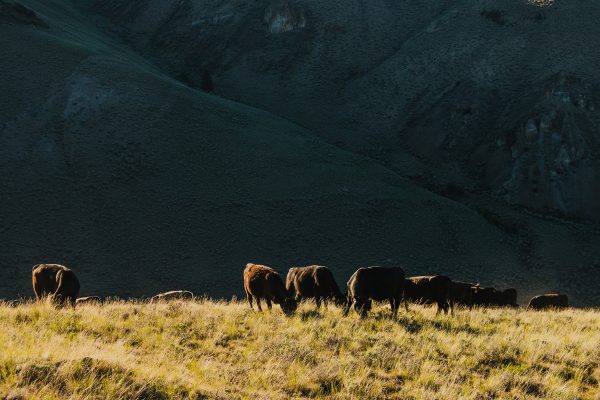There’s more to springtime than the beauty of life regenerating. It’s a real pleasure to be working outside with critters and grass. But the irony is that spring is also the time of many, many government meetings. The beeves, birds, and coyotes have it made!

Of course, like everyone else, we have a fair amount of tax reporting (80 some pages this year). Then there is the organic systems plan (usually over 90 pages). Add to that several meetings with the federal agencies on whose land we have our 70 square mile summer pasture and a review of our grazing plans and our weed management plan. This latter plan is quite a bit of work, but pretty exciting (at least to us).
Caryl and I develop this weed management plan every year, and the federal agencies and the county weed board review and sign off on it. The plan details what weed control efforts we took the year before, and our plans for this year. Last year we spent over 300 man (and woman) hours on the range controlling weeds, mostly by hand grubbing, but also by releasing insects that target the non-native invasive weeds.
Why this matters to you is that these efforts mean that the entire 70 square mile rangelands is chemical free and certified organic.
So even though it is spring and I’m itching to go outside, I’ll spend the time to make sure that all of these manifestations of government in our lives go well, and we have good relationships with them all (except maybe the IRS; is it possible to have a “good relationship”?). These relationships are important to be able to continue doing what we do.
Yesterday we had a chance to show a little about what we do (and why) in an enjoyable afternoon with students from the University of Idaho’s Integrated Rangeland Management class (taught by Dr. Karen Launchbaugh). We took the 30 or so students and instructors for a 4 hour tour on the home ranch and on the range.
Caryl and I presented about Alderspring’s operation, and how you, our partners, have made what we do here possible. We shared with them about the diversity of landscapes that an Alderspring steer travels on its 120 mile annual walk each year in its life on the ranch.
We started with the students on the calving pastures, where new babies are being born daily, then moved on to the yearlings, who came stampeding up at my call to pay the group a visit. I think the students were a little unnerved by Billy Bob who came up behind me and almost knocked me over on his way to the students. The 1000 lb Angus steer got right in the face of some of the young women, but to their credit, they stood firm.
Then we headed up to our summer range, just coming abloom with native wildflowers and grasses, waving in the warm spring breeze. I showed them Native American and trapper pack trails that could still be seen, the route those two parties took packing beaver pelts, buffalo booty, and chinook salmon between their abodes far up on our range on Hat Creek and the protein-abundant Salmon River canyon and Pahsimeroi Valley beyond. It was hard to believe that just two centuries ago, this was still happening. You could easily picture Shoshonis on horseback riding through us as we talked, as the country today was virtually unchanged since then. Caryl took a picture of me pontificating, and posted it on ourFacebook page.
We also showed them the evidence of explosive volcanism on a catastrophic scale that occurred long ago here, resulting in huge lava flows, ash deposits hundreds of feet thick and jagged peaks and rock formations. In fact, one of the most common of the grasses on our summer range only occurs here, on our range and in the Challis, Idaho area, and nowhere else in the world: Salmon River wildrye. Its distribution is due to the unique, rich volcanic soils and dry climate of our canyon country.
Caryl was standing on one of those white, gritty, ash deposits, and asked the range students to taste a blade of the tall wildrye, caressed by the breeze. The soft, blue green blades are sweet and yet very mineralized tasting, and betray the nutrient dense soils that it roots on. It was a virtual wilderness where we were standing, and I could easily assume that few if any white people had ever stood there, let alone sprayed or applied chemicals to it.
It was Caryl’s desire to try to make those students understand that these wild rangelands are not “wastelands” or left over non-productive lands, but actually represent the most ancient, sustainable, nutrient-producing form of agriculture that there is. She talked about how many of our beef customers depend on us for that uncompromised nutrition density, and how our beeves will select those plants from this wild diversity to meet their own nutrition needs first. After all, as Michael Pollan said: “you are what you eat eats”.
She also described that the reason many customers depend on us for that elevated and pure nutrition is because their bodies are compromised, often from autoimmune diseases like lupus, MS, and rheumatoid arthritis. Recent studies also suggest a link between cancer and autoimmune responses. For several of our customers, our beef is the only thing they find they do not have an adverse response to.
Scanning over our college students, I saw that there was a little bit of the deer-in-the-headlights look about them. Caryl noted the same thing and fingered it when she said in her talk that because they were young, they had not yet personally experienced any of these health problems. They could not relate. But wasn’t it just a matter of time for these pepsi-drinking 20 somethings? It seems to us that more than half of the people we knew in our baby boomer sugar consuming, processed food generation have digestion, heart, cancer, and autoimmune issues.
Here is the other thing we have noticed: Why do relatively fewer folks in their eighties experience the gut or autoimmune issues that we 40-60 year olds (and even younger) seem to be plagued by? My theory is that it has to do with their diet in their formative years.
It was wartime in the Nazi-occupied Netherlands for my parents. Starvation in cities like Amsterdam was rampant due to the Nazi war machine’s insatiable appetite for food. Thankfully, my then teenager parents were living in the farm country of the north province of Friesland. Sugar and fruit and other imported items were non-existent. They had only the produce from their gardens and farmsteads to eat. Even the lean beef cuts were taken by the occupiers, and the Dutch were left with fat, gristle and bones. Milk was still available on occasion; because it was so perishable it was less often taken by the Germans.
By force, my parent’s fare was a whole foods diet derived from intact soils that never experienced any agri-chemicals. Their gut biota and functionality were established on living, nutrient dense food, and it set the pattern for a lifetime of resilience that serves them to this day: my father is 89 last week, and still lives a very active life, biking daily, doing some manual labor, and preparing to recreationally boat his summer away in his small sailing vessel. I’m hoping that the restorative power of whole food will enable Caryl and I to do the same someday.







Leave a Reply